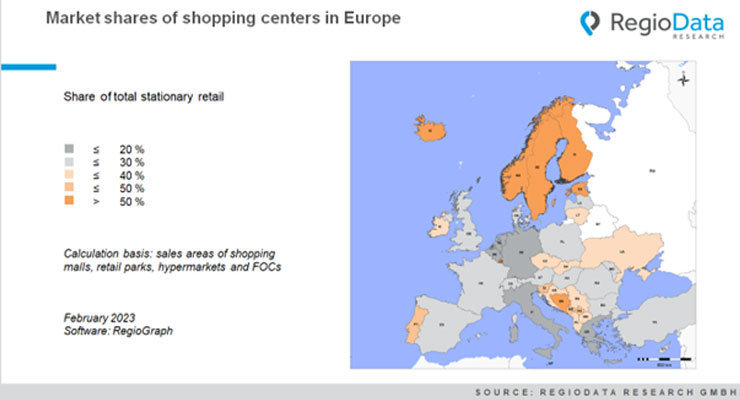by RegioData Research GmbH
But the extent of this dominance varies astonishingly, ranging from a whopping 63% (Iceland) to a meager 8% (Greece): RegioData Research has determined the market shares of each country’s total stationary retail trade for the first time – based on the current shopping center database with over 12,000 centers.
At first glance, it is apparent that northern Europe is well-covered with shopping centers. In some parts of Central Europe, the importance of shopping centers is significantly lower, while in the SEE countries, a considerable number of large shopping centers have emerged – and will probably continue to do so. Climate, settlement structures, legislation, and purchasing power are the main factors influencing these differences.

Iceland has by far the highest shopping center share in Europe at 63% of the total retail trade. Estonia takes second place with just under 55%, and Norway third with 53%. Luxembourg and Sweden are also in the top 5 with just over 50%, mainly due to the northern weather conditions and the often smaller and less retail-oriented city centers. Accordingly, people are fleeing to shopping centers. In Northern Europe, shopping centers have unusually large sales areas, so sizes of over 60,000 sq m are not uncommon. While shopping centers are booming in some countries, the trend is stagnant in large parts of Central Europe. Italy and Germany, in particular, have a low proportion of shopping centers in terms of floor space. With a national sales area of just under 125 million sq m, shopping centers in Germany account for only about 15.6% of this. In Italy, the shopping center share is 17%. In both countries, inner-city shopping streets dominate the existing sales areas.
The high-flyer of the current shopping center outlook is the Balkan region. Here, the market shares of shopping centers are rising continuously, especially in Bosnia and Herzegovina. At just under 47%, Bosnia holds the eighth-largest shopping center market share in Europe, placing it close behind the Scandinavian countries. The high figure is partly due to the expansion policy of the Bingo chain: the company is considered the country’s top-selling food group and is thus the market leader. Now Bingo is even said to be implementing shopping center projects totalling over 200,000 sq m. Secondly, apart from the capital Sarajevo, there are hardly any established shopping streets to satisfy people’s purchasing needs. The development in the Balkan region is somewhat reminiscent of the turn of the millennium, especially in Romania and Poland, where high dynamics of shopping centers occurred, yet the purchasing power was still low. Thus, the high shopping center market shares in the Balkan region and the current expansion projects are risky, given the current purchasing power.






